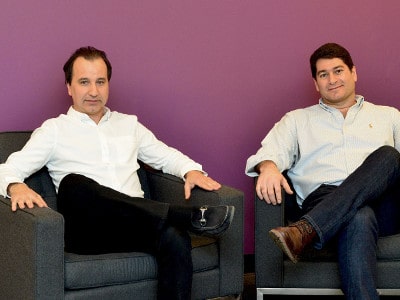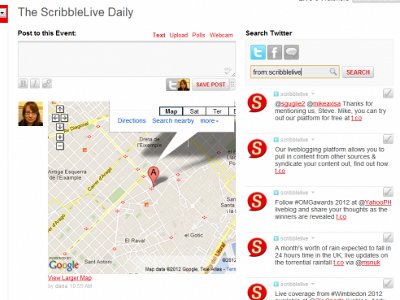

Earlier this month, Toronto-based content marketing platform ScribbleLive acquired Appinions, a natural language processing and social media monitoring analytics platform developed over the course of 10 years by Larry Levy and Dr. Claire Cardie at Cornell University.
The integration of the Appinions data engine into ScribbleLive’s real-time content publishing platform represents a significant step forward in terms of taking Big Data and analytics seriously for the purposes of effectively measuring things like social media sentiment for publishing purposes.
After raising a $12 million Series C fundraising round led by the WIN (Waterloo Innovation Network) Fund last October, ScribbleLive began development of an in-house Big Data and natural language processing engine called Social Discovery.
What ScribbleLive learned from the experience of developing their own engine is that Big Data and analytics is serious, hard stuff, incredibly difficult to do effectively. There are certain types of expertise that it is simply more effective to acquire.
As CEO Vince Mifsud told me recently, “We discovered, in fact, that it was very complicated and it would be way better to start with a strong team that have already developed a strong piece of technology and build off of that.”
Cantech Letter talked to Mifsud recently by phone to discuss ScribbleLive’s approach to fundraising, the catalytic moment of the Boston Marathon bombings, and the future of content as it continues to evolve during this transformational period of media history.
How did you come to be involved with ScribbleLive? What’s the leadership structure like?
I was brought into ScribbleLive about three years ago by the founders. The original two founders brought me in to help build and scale the business. Our board members come from two groups. There’s obviously the investors, who’ve put a lot of capital in. They often get a board seat as part of their investment. That’s kind of standard practice, as far as any big investor. And then there are the independent board members that you bring in. Those are people who are there if you’ve got an area that you’re trying to get some value from, exptertise-wise or in terms of knowledge. So there’s Howard Gwin. There’s David Alston, who is a marketing guy in enterprise software. Generally, we use our networks and we have a certain profile of people, just like finding anybody else in your company. Board members have had enterprise software experience, generally, for our size and scale. We take a proactive networking approach to finding the right board members.
It seems like what sets ScribbleLive apart from the other social media or microblogging sites who use data mining and sentiment monitoring is an emphasis on breaking news. You have an association with mainstream media now, aside from your brand associations. How did you figure out that that was your strong suit?
The initial products were what we would call “live publishing”. The idea was, how do you create content very quickly and distribute it to a web property, a microsite, in a rapid way? So that if there was a breaking story or a sports event that was moving quickly, how do you cover that particular story in a real-time way? That was the inception of the platform. It was about publishing content rapidly. What we’ve done since then is we’ve built out a much broader platform that not only allows you to create content, which is this rapid publishing engine that I talked about, but when you think about content, it generally has a lifecycle that starts with a plan. You’ve got a plan for your content, you’ve got to create it, then you’ve got to distribute it to the right channel and then you want to measure what’s working and what’s not. We call that a lifecycle. We’ve been building out all the pieces so that you can plan, create, distribute and measure very rapidly. Since the inception, we’ve built out the entire lifecycle platform. The acquisition of Appinions, the reason we did that is, we can use data science in each step of those processes to create recommendations to optimize what you’re doing so that you get the best payback on your marketing efforts. So when you’re planning, or collaborating on a project, the Appinions engine actually tells you algorithmically what to write about for a particular topic. It creates this cluster of themes. Let’s say you want to go after the 3D printer market, you put in to their algorithm “3D printers” and it spits out all of the themes and topics that normally get written about in and around 3D printers that you want to write about to get market traction in that segment. So that’s under the planning bucket. Under the creation bucket, it scours six million sources of content and based on the themes you’re looking for, it surfaces great content in the web and social sphere. And it surfaces content that gets what you’d call reactions or statements of opinions, which helps you create. And then it also measures influencers. Who are the people in the market that create influence, both people and publishers? And it measures your share of influence in a market. We found that this data science engine can play a part in the entire lifecycle of content. That’s why we thought it was a great acquisition, because it’s a very synergistic value proposition.
It feels like the definitive use case for ScribbleLive was really during the Boston bomber manhunt. That’s where we saw all this content cohere onto your platform, with big-name news organizations leaning on ScribbleLive, more so than they did on Twitter. How did that play out as a catalyst?
If you think of Twitter and Facebook and LinkedIn and whatever other social channels you want to think about, that’s a channel where there’s a lot of audience and if you’re a particular news organization or you’re a brand, the idea is that you’ve got these big audiences, but ultimately you want to bring them back to your brand. So you use Twitter and Facebook and LinkedIn as great channels to push out content, tell people about your story, and then you bring them back to a microsite where you rapidly push content to them and create interactivity, so they’re engaged with your brand, right? So what we do is allow you to push content out to the social channels, bring people back to a microsite or your web property, and then have the ongoing interaction and engagement happen on your own property. Of course, then you send content back out and it’s like a circle, right? You push content out to social, attract the audience, bring them back, create the interactivity, push out the content, and you create this circular kind of value prop. So we see Twitter and all those guys as important partners, because we’ve got to get our content out there. They have the large audiences. If you’re a publisher, you want to bring those audiences back to your web property, where you have interactivity. So that’s the idea.
So whereas Twitter uses a hashtag as a container to say, “This is the topic that we are talking about,” ScribbleLive feels more like a television channel on a specific subject, whether it’s the Boston Marathon bombings or the hockey playoffs or whatever, on a breaking story.
Yeah, that’s one of the use cases of Scribble, where you can create these containers and they can look like many different front-end experiences. It can look like a stream, it can look like a pinboard of photos, you name it. You can have content talking about a particular topic in a stream, and that’s one way to use it. The other way to use it, it doesn’t have to be in a breaking news environment, it could just be a Q&A session about a particular topic. You’re a leading brand or financial institution and you want to talk about whatever, you can create this Q&A where the audience is interacting with you. We have some customers that create an ability for users to email in photos and create this collage of photos, which is really engaging and really attracts an audience. So it can be used in many ways, but ultimately what we call it is a “content marketing platform”. So inside of the ScribbleLive platform, you create a content plan, you actually create the content, and then you distribute it and measure its effectiveness. That’s what the platform does. It’s an entire content marketing platform.
“Advertising is becoming less impactful, because it’s just too noisy. We learn to filter it out. We’re trying, as consumers, to read the stuff we care about reading. That’s why we think the market we’re in is huge.” – ScribbleLive CEO Vince Mifsud
Coming back to analytics, then, back in December, a few months before the Appinions acquisition, you launched something called ScribbleLive Social Discovery, which I gather was the in-house version of what you ended up acquiring Appinions to accomplish.
Yeah, that’s a great question, because that was kind of a catalyst. And what we discovered is that data science is very complex. It’s not an easy thing to do. It’s very hard to do. And you need very specialized mathematics and Big Data skills on your engineering team to do that well. When we did it, we said, “This is an area that requires very deep domain expertise in natural language processing, in mathematics. We should acquire that talent to get ourselves started in that market.” We would have a faster time to market. We did a very light version of the tests to see how complex it was, the Social Discovery module you were talking about, and we discovered, in fact, that it was very complicated and it would be way better to start with a strong team that have already developed a strong piece of technology and build off of that. So that’s what we’re doing. We have the team in New York. They’re a data science team and the goal is to continue to build expertise from that initial team.
I was really impressed, reading about the team behind Appinions. For two people, a 10-year time period of Cornell University development. This is heavy stuff. I think that a lot of people who are looking at Big Data solutions don’t realize, this is hard to do.
Exactly. To get real value out of Big Data, it’s hard. To get algorithms that are working and really finding new, meaningful insights, it’s hard. So we were very fortunate to get the team, and they’re a very strong engineering team.
“We can use data science in each step of those processes to create recommendations to optimize what you’re doing so that you get the best payback on your marketing efforts. So when you’re planning, or collaborating on a project, the Appinions engine actually tells you algorithmically what to write about for a particular topic. It creates this cluster of themes.”
Aside from that acquisition, which seems like it was more a complementary acquisition, you’ve also grown through acquiring competition, like CoveritLive. What’s the strategy when you’re considering an acquisition?
We think mainly in the area of building out our product. The main objective of the acquisitions we’ve been doing is, do they have some interesting domain expertise and talent, or a great product that we can incorporate into our platform, to make our platform just that much better than it is, or hopefully better than the competitors? So we look at it a lot from a product perspective. The CIL acquisition, even though it looked like a competitor, it was a competitor, but it was more along the lines of sports marketing. They had a lot of clients that were sports marketers: sports leagues, sports teams and lots of expertise in that area. So we saw them as a good engineering group to help us create that segment of the market. We’ve been embedding all of their sports-related features into our platform for the sports marketers. So again, that was a product-centric decision.
ScribbleLive has raised a little over $20 million in outside fundraising. Which, I’ve got to say, compared to other Canadian social monitoring technology-focused companies, is quite a modest amount. Your revenue growth over the last couple years is north of 100% annual growth. When you’re considering going out to raise funds, what goes into optimizing that fundraising?
We think about a few things. Number 1, is the market big enough, is the opportunity big enough to justify continued investment in sales and marketing in order to capture the market? Is the timing there so that you can accelerate your growth by investing more? So we think about the market readiness, if you will. We sensed that content marketing was becoming more and more ready for disruption and technologies like Scribble. We look at product innovation, and think about the investments in research and development, the continued innovation, to keep the platform ahead of the competition. You know how it is in technology. You can get overwritten if you don’t invest in that area. So we think of those two buckets and watch the competitive landscape very closely. Our competitors are primarily U.S. They’re capitalized at a much stronger rate than Canadian companies, typically. Just to give you an idea, the competitor that we see as a direct competitor to us has raised between two and three times the capital that we have raised and are basically around the same size. So they haven’t necessarily got more traction out of it, but they’ve used up a lot more capital. We watch the competitors because they throw a lot of money at something. We want to make sure that we don’t lose our innovation advantage on the product. So we look at that. The third thing we look at, I think, is the nature of the investor intending to help us succeed in the business. So we’re looking for value-added investors, not just financial investors. Good people, with good connections into their industry. So we get those other pieces of value, besides just their financial value. For example, Georgian Venture Partners, they have a very strong data science team. When we did the acquisition of Appinions, we actually got Georgian to do the due diligence for us on the technology, because they’re such strong data science guys. So, what a great partner that can go out, look at the pure math and science piece and go, “Hey, this is great engineering.” So that’s an example of a value-added investor, in our view. The Export Development Bank of Canada is another example. When you’re dealing internationally, it’s always great to have the EDC on your side. It gives you credibility, it gives you stature in other markets, things like that. Everybody on our board has value. Rogers Ventures Partners, they’re also a customer of ours. They’re in Silicon Valley, they’re very well connected down there. Summerhill, out of Boston, they’ve got a huge network. They’ve been in business for a long time. They can connect us to a lot of people in Boston. Everybody adds value. We’re looking for that piece, as well.
These days, the lines are blurring between internet content marketing and native advertising. How do you see that shaking out over the next two or three years, if you could push it in a certain direction?
I think that advertising generally is becoming less and less effective. You and I have learned to filter out advertising in many ways. If you watch behaviours of people, they don’t watch TV. During intermission, even if they watch TV they’re connected to their mobile device or tablet. So they’re not connecting with the commercials. So it’s becoming harder to connect with your audience and to generate awareness of your brand through pure advertising. So our view is that pushing out great content that your audience cares about is the way to do it, and the way to build leads if you’re a B2B brand, or if you’re B2C, the way you can engage with your customers, or if you’re media, you get people to come back and read the content on your media site. Our view is that content marketing is becoming the new form of raising awareness and interest in your products. And advertising is becoming less impactful, because it’s just too noisy. We learn to filter it out. We’re trying, as consumers, to read the stuff we care about reading. That’s why we think the market we’re in is huge. Because it’s going to, over time, keep nipping away at traditional advertising.
Leave a Reply
You must be logged in to post a comment.






 Share
Share Tweet
Tweet Share
Share




Comment